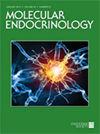Activation of AMPK Stimulates Neurotensin Secretion in Neuroendocrine Cells.
Q Biochemistry, Genetics and Molecular Biology
引用次数: 6
Abstract
AMP-activated protein kinase (AMPK), a critical fuel-sensing enzyme, regulates the metabolic effects of various hormones. Neurotensin (NT) is a 13-amino acid peptide predominantly localized in enteroendocrine cells of the small bowel and released by fat ingestion. Increased fasting plasma levels of pro-NT (a stable NT precursor fragment produced in equimolar amounts relative to NT) are associated with an increased risk of diabetes, cardiovascular disease, and mortality; however, the mechanisms regulating NT release are not fully defined. We previously reported that inhibition of the mammalian target of rapamycin (mTOR) complex 1 (mTORC1) increases NT secretion and gene expression through activation of the MEK/ERK pathway. Here, we show that activation of AMPK increases NT secretion from endocrine cell lines (BON and QGP-1) and isolated mouse crypt cells enriched for NT-positive cells. In addition, plasma levels of NT increase in mice treated with 5-aminoimidazole-4-carboxamide riboside, a pharmacologic AMPK activator. Small interfering RNA-mediated knockdown of AMPKα decrease, whereas overexpression of the subunit significantly enhances, NT secretion from BON cells treated with AMPK activators or oleic acid. Similarly, small interfering RNA knockdown of the upstream AMPK kinases, liver kinase B1 and Ca(2+) calmodulin-dependent protein kinase kinase 2, also attenuate NT release and AMPK phosphorylation. Moreover, AMPK activation increases NT secretion through inhibition of mTORC1 signaling. Together, our findings show that AMPK activation enhances NT release through inhibition of mTORC1 signaling, thus demonstrating an important cross talk regulation for NT secretion.AMPK的激活刺激神经内分泌细胞的神经紧张素分泌。
amp活化蛋白激酶(AMPK)是一种重要的燃料感应酶,调节各种激素的代谢作用。神经紧张素(NT)是一种13个氨基酸的肽,主要存在于小肠的肠内分泌细胞中,并通过脂肪摄入释放。空腹血浆前NT(相对于NT产生等摩尔量的稳定NT前体片段)水平升高与糖尿病、心血管疾病和死亡率风险增加相关;然而,调节NT释放的机制尚未完全确定。我们之前报道过,抑制哺乳动物雷帕霉素靶蛋白(mTOR)复合物1 (mTORC1)通过激活MEK/ERK通路增加NT分泌和基因表达。在这里,我们发现AMPK的激活增加了内分泌细胞系(BON和QGP-1)和分离的NT阳性小鼠隐窝细胞的NT分泌。此外,5-氨基咪唑-4-羧酰胺核苷(一种药理学AMPK激活剂)治疗小鼠血浆NT水平升高。小干扰rna介导的AMPKα敲除减少,而亚基的过表达显著增强,经AMPK激活剂或油酸处理的BON细胞分泌NT。同样,上游AMPK激酶,肝激酶B1和Ca(2+)钙调素依赖性蛋白激酶激酶2的小干扰RNA敲低也会减弱NT的释放和AMPK的磷酸化。此外,AMPK激活通过抑制mTORC1信号传导增加NT分泌。综上所述,我们的研究结果表明AMPK激活通过抑制mTORC1信号传导增强NT释放,从而证明了对NT分泌的重要串扰调节。
本文章由计算机程序翻译,如有差异,请以英文原文为准。
求助全文
约1分钟内获得全文
求助全文
来源期刊

Molecular endocrinology
医学-内分泌学与代谢
CiteScore
3.49
自引率
0.00%
发文量
0
审稿时长
12 months
期刊介绍:
Molecular Endocrinology provides a forum for papers devoted to describing molecular mechanisms by which hormones and related compounds regulate function. It has quickly achieved a reputation as a high visibility journal with very rapid communication of cutting edge science: the average turnaround time is 28 days from manuscript receipt to first decision, and accepted manuscripts are published online within a week through Rapid Electronic Publication. In the 2008 Journal Citation Report, Molecular Endocrinology is ranked 16th out of 93 journals in the Endocrinology and Metabolism category, with an Impact Factor of 5.389.
 求助内容:
求助内容: 应助结果提醒方式:
应助结果提醒方式:


